Words and Photos by Kevin Siemonsen
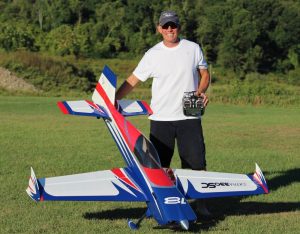
Building and flying RC models is a hobby that does not discriminate. The very moment you think you know it all, you get a harsh reminder that nothing could be further from the truth. With that opening statement in mind, let me tell you my $1500 lesson of hard knocks!
When reviewing a model plane I make it a point to use the components that accompany the kit. What I’m referring to are generally hardware items such as tail wheel brackets, wheels, hinges, fuel system components, servo arms, control linkages, etc. Where this lesson starts is with a 28% Flight Model Extra 330 with DA 35 engine, canister exhaust and loaded with high end Hitec electronics. This airplane was an absolute blast to fly and being a small gasser, would even fit in my Subaru.
This saga begins at a fly-in near Downsville NY. While camping overnight I had my Extra sitting under an EZ up awning. In the early hours a gust of wind scooped up the model, sending it cart-wheeling down the flight line. I came out of the camper to see what all the commotion was about to see an empty EZ up and my plane listing some 25 yards down the flight line. An onlooker witnessed the wind hurtling my poor plane down the line. Evident were the broken landing gear and surface blemishes from its tumble.
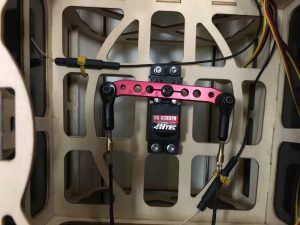
Upon returning home I replaced the landing gear and looked into the rudder. There was hard over evidence with the elevator impression moshed into the side of the rudder. I powered up the radio and noted that the rudder did not center and if you moved the rudder stick quickly you could hear skipping. It was obvious, or I thought anyway, that the rudder servo gears were stripped. I replaced the rudder servo, centered things up and the Extra was ready to go!
Fast forward to a fly-in in Kingston Ontario Canada. I trekked the Extra the 400 miles from Connecticut to Kingston for the Fathers Day event. Gas up the Extra and put her up for a flight. All things were going until I was attempting an outside loop with an outside snap roll on top. That’s when things went from bad to worse. Upon neutralizing the controls for recovery the Extra maintained an “odd” attitude. I applied up elevator because I was, of coarse, low and approaching trees at a feverish pace. The Extra did an unexpected snap roll?! Things were really messed up and the fact that I was now a nano second from the trees made things that much worse! I neutralized the controls again and with the plane now inverted, gave down elevator that induced yet another snap roll. By this time the plane was practically already in the trees and there was no time to compute what the hell was going on. A second later it was all over, with my coveted Extra parked on top of a great big Canadian pine tree! The noise of a large scale gasser crunching its way through the braches is stupendous … and horrifying all the same! I began the walk of shame towards the wreckage and had no problem finding it … I crash as close to the field as possible and wreckage in the top of the tree is clearly visible. Below the tree lie the money end of the Extra. This encompassed the beautiful DA 35 engine, but only two servos. Up in the top of that damn pine tree was a wing panel and rear end of the fuselage.
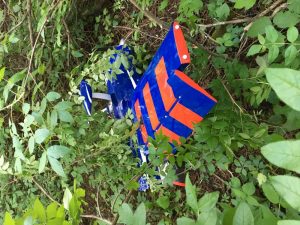
For two days we watched the mother nature try to blow the bits out of tree. I thought for sure that wind gusts of 20+ mph would blow them down, but to no avail. The club had a chain saw, which I declined, in favor of a monstrous telescopic pole. I extended the pole from under the tree with the branches acting as guides, preventing the pole from bowing. As we poked and prodded at the plane the “peanut gallery” cheered from the flight line. This went on for about an hour with the remnants being reluctant to leave their perch. I was eventually able to retrieve the carcass and looking at the bright side, packing up the car would be much easier.
I was bothered about that crash. I typically crash because of a mistake, whether it be poor judgment or a wrong control input. Something seemed odd about this one, so I did a mini NTSB crash investigation. I found that when the rudder servo was centered the servo arm was not. I applied some force to the servo arm and sure enough, the splines were stripped. In the photos you will note that a black servo arm provided from the kit manufacturer was fastened to the original equipment servo arm. In the beginning of this article I mention how I try to use accessories included in the kit. When it comes to servo arms, I highly recommend that you DO NOT EXTEND ORIGINAL EQUIPMENT SERVO ARMS!!! The nylon servo arm is not designed to be extended and in doing so you could be setting up for failure!
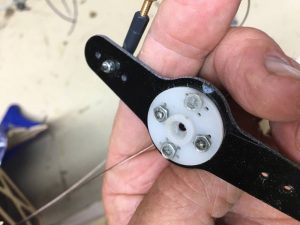
The reason my plane crashed was because when the wind tumbled it down the flight line in Downsville, I failed to notice the servo arm was stripped. In my infinite wisdom I replaced the servo that worked great until there was and abrupt load. At that moment, the control the arm slipped on the servo. When the control sticks were centered, the rudder was not. I then proceeded to give elevator which was actually commanding a snap roll. Major bummer.
Today’s servos are torque monsters and rotational loads can be too much for nylon servo arms, especially when extended and the control gets bumped! There is an easy solution known as SWB. Since 1988, SWB has been an aftermarket manufacturer of performance aluminum model aircraft accessories that pioneered the industry. SWB is most noted for its high performance aluminum anodized servo arms. The SWB servo arm is superior, with a clever clamp design that maximizes engagement of the servo arm to servo output shaft. SWB arms come in a multitude of shapes and sizes and are available for all major radio brands. In the event that you’re not sure what you need for the job, Scott at SWB can help you choose the correct arm for your application.
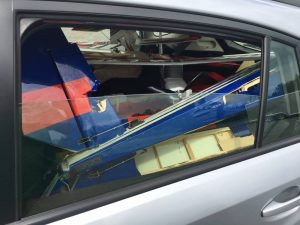
This was a long winded lesson learned story so I’ll keep the ending short and sweet. If I had an SWB servo arm on my plane I’d still have it today. Don’t overlook replacing a 5-10 dollar part that might cause you to lose your 1500-2000 dollar model. The end!
LINKS
 Fly RC Magazine WE LIVE RC
Fly RC Magazine WE LIVE RC
